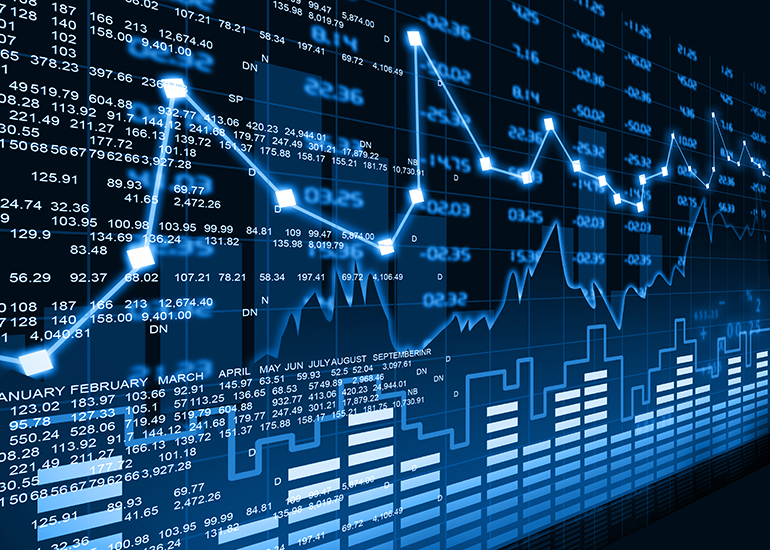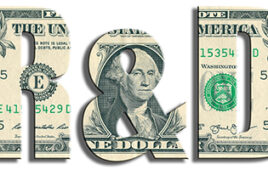
The R&D World Index for the week ending January 15, 2021 closed at 4,068.07 for the 25 companies in the R&D World Index. The Index was down 1.22% (or 50.19 basis points) from the week ending January 8, 2021. The stock of 14 R&D World Index members gained value from 0.14% (Johnson & Johnson) to 16.05% (General Motors). The stock of 11 R&D World Index members lost value from -0.11% (IBM) to -3.91% (Alphabet/Google).
 Heavy global demand for semiconductor chips has swamped most chip suppliers’ capacities. Driving much of this demand is the heavily R&D-based development and the increasing electrification of vehicles, new 5G-equipped smartphones, pandemic-based work-at-home computer systems and other consumer electronics. Ford has idled some factories due to chip shortages and GM has informed its suppliers to stockpile a year’s worth of chips. These demands are causing a number of changes in the global semiconductor industry. Long-time performance device leader Intel fired its current CEO Bob Swan last week and announced the appointment of 30-year Intel veteran Pat Gelsinger as its new CEO. Gelsinger was Intel’s first chief technology officer. He now has to deal with reviving Intel’s falling market share and the departure of key technology personnel. He also must deal with increasingly aggressive competitors including Nvidia (now the U.S.’s most valuable semiconductor firm) who plans to purchase the U.K.’s Arm Holdings, long-time direct and growing competitor AMD who plans to purchase Xilinx, and long-term customer Apple who now is building its own performance computer chips.
Heavy global demand for semiconductor chips has swamped most chip suppliers’ capacities. Driving much of this demand is the heavily R&D-based development and the increasing electrification of vehicles, new 5G-equipped smartphones, pandemic-based work-at-home computer systems and other consumer electronics. Ford has idled some factories due to chip shortages and GM has informed its suppliers to stockpile a year’s worth of chips. These demands are causing a number of changes in the global semiconductor industry. Long-time performance device leader Intel fired its current CEO Bob Swan last week and announced the appointment of 30-year Intel veteran Pat Gelsinger as its new CEO. Gelsinger was Intel’s first chief technology officer. He now has to deal with reviving Intel’s falling market share and the departure of key technology personnel. He also must deal with increasingly aggressive competitors including Nvidia (now the U.S.’s most valuable semiconductor firm) who plans to purchase the U.K.’s Arm Holdings, long-time direct and growing competitor AMD who plans to purchase Xilinx, and long-term customer Apple who now is building its own performance computer chips.
Taiwan Semiconductor Manufacturing Co. (TSMC) is the world’s largest contract chip maker for customers that include Nvidia, AMD, Apple and even Intel. TSMC expects to invest up to $28 billion in 2021, a more than 50% increase from 2020. TSMC also has announced plans to build a new fab in Arizona. U.S.-based Globalfoundaries has also announced it is doubling its capital investment in 2021 from its 2020 investments to boost capacity. Analysts studying this extreme semiconductor device demand surge expect it to continue for several years and expect ICT R&D investments to follow the surge.
After using Intel microprocessors in its Mac computers since 2006, Apple started employing its own design microprocessors in its Macs in November 2020. The company actually removed its older models using Intel chips from its online store. The gamble worked and customers snapped them up.
Numerous global R&D organizations have and are developing vaccines for the COVID-19 pandemic. Distribution of some started in November 2020. The Beijing, China-based biopharmaceutical company Sinovac developed CoronaVac which was initially touted as being 78% effective in late-stage trials in late-December and offered total protection against severe cases of the disease. Brazilian scientists, however found that the efficacy rate was only 50.4% in its late-stage trials. This efficacy rate still meets the 50% threshold that the World Health Organization (WHO) considers good enough for widespread use, but the trial’s organizers believe they were misled. This also may lead to other potential users to consider other drugmakers whose vaccines have higher efficacy rates.
An MIT (Massachusetts Institute of Technology) mechanical engineering professor/researcher was charged last week by federal prosecutors for failing to disclose extensive ties and funding from the Chinese government in research grant applications to the U.S. Department of Energy. The researcher was born in China and is a naturalized U.S. citizen. Federal prosecutors have brought more than a dozen criminal cases accusing academics of receiving Chinese government funding or their affiliation with the Chinese military. Prosecutors state that the MIT researcher has received $19 million in federal grants since 2013, along with $29 million in foreign funding, including $19 million from a Chinese research university funded by the Chinese government.
About the R&D World Index
R&D World’s R&D Index is a weekly stock market summary of the top international companies involved in research and development. The top 25 industrial R&D spenders in 2019 were selected based on the latest listings from Schonfeld & Associates June 2020 R&D Ratios & Budgets. (Amazon is the top R&D spending organization in the world and has been left out of the R&D World Index since its high stock value would significantly affect the overall index all by itself). These 25 companies include pharmaceutical (10 companies), automotive (6 companies) and ICT (9 companies) who invested a cumulative total of nearly 260 billion dollars in R&D in 2019, or approximately 10% of all the R&D spent in the world by government, industries and academia combined, according to R&D World’s 2021 Global R&D Funding Forecast. The stock prices used in the R&D World Index are tabulated from NASDAQ. NYSE and OTC common stock prices (in U.S. dollars) for the companies selected at the close of stock trading business on the Friday preceding the online publication of the R&D World Index.


Tell Us What You Think!